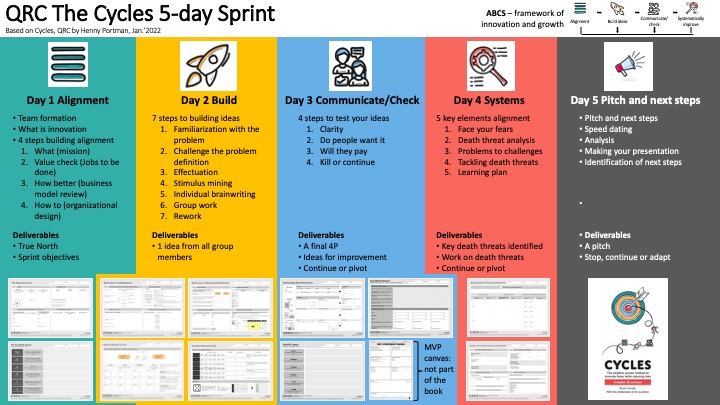
The book Cycles – The simplest, proven method to innovate faster while reducing risks, written by Bryan Cassady with the collaboration of 22 co-authors, offers not only the ‘why’ and ‘what’ but also the ‘how’ of innovation.
The main parts of the book follow the author’s ABCS framework:
- A – Alignment. Alignment is the foundation of effective growth. It is about an honest assessment of who you are (culture). It is about finding what is important (mission) and matching this with what the market wants (needs) and plans to deliver value (fit with skill and business models). It uses 4 steps (canvases) to get aligned: mission, meaningful value, delivered better through business model innovation and with a culture to do it better. And you must set your direction with true north (canvas).
- B – Build ideas. Once you know what you want to do it is time to build ideas that have a chance to deliver on your objectives. Contrary to the belief that the ability to build ideas is limited to a select few, there are tools, techniques that can help any team build better ideas. These tools are: effectuation (looking for ideas at home with the resources you have), systematic search for stimulus (get out of the building) and diversity and willingness to bring in new people/resources. It uses 8 steps (canvases) to create better ideas: Familiarize yourself with objectives and challenge, rethink your opinion, what do you have?, using what you have to take action and stimulus mining, individual brain writing, extending ideas with feedback and groupwork mix and match. And as final steps you must look for stimulus related to your challenges and make a spark pack and mix and match ideas to build better ideas by choosing 1 set of unrelated stimuli and roll the dice.
- C – Communicate and Check. If you’re looking to build bigger and better ideas, you need to get feedback. To get effective feedback you need to be able to explain your ideas clearly, really listen (listening is not just hearing!), slow down to make sure you are on the right path, and most importantly be ready to kill bad ideas. It uses 4 steps to clarify and check your ideas: clarity, analysis, will they pay? can you make it work? When your ideas need clarity you can use the 4 P’s canvas (problem, promise, proof and payoff). And a simple format to test your ideas: present your ideas and get feedback (one at a time). Note: Here I would add an extra MVP canvas.
- S – Systematically improve. A lot of research has shown that systems are the key to innovation success. Systems are made up of interrelated components of people and processes with a clearly defined, shared destination or goal. Systems work best when everyone shares an understanding and commitment to the aim or purpose of the system. The foundations are clarity and a commitment to learning and improvement. Great companies have 3 characteristics that set them apart from the rest. These characteristics are: an ability to see and build on strengths, a commitment to building innovation eco-systems and a commitment to ongoing action. Even if you’re not afraid it is good to start by finding your fears (canvas). It uses 4 steps (canvasses) to improve your innovation process: How is the system blocking you? Convert problems into challenges, deal with the death threats and set up a learning plan.
To download the QRC:
The final part brings it all together. Use behavioural science and habit-building to deliver sustainable innovation. Most new initiatives begin by focusing on motivating people by announcing new strategies in a big launch and expecting change to follow. Unfortunately, this approach generally fails. The reason is simple; behavioural science tells us that motivation and incentives are not the most effective ways to get people to change what they do. The best approach is quite simple; first, new behaviours are facilitated, and then controlled repetition of these behaviours creates habits. Habits become the foundation of real and lasting change. It uses 4 steps (canvases) to create better habits: what habit do you want to create, rank-order, identify the single tiny habit you can achieve, ways you’ll make this habit easier and reinforcement.
In total 28 chapters. Every chapter explains the theory behind one or more canvases. It ends with key take-aways, next steps and next up. Note: No clue why the author uses every time the same symbols as he uses for the first two steps of the ABCS framework alignment and build ideas to refer to next steps and next up.
In the appendix you get a comparison between a design sprint and the ABCS run as a 5 day sprint.
Conclusion. A great book to support you in your journey to become more innovative. The ABCS framework helps you to decide what to do next (A – Alignment, B – Build ideas, C – Communicate and Check and S – Systematically improve). It contains theory, cases, techniques, many lists with steps to be taken, lots of references to books with more in-depth information, and each chapter ends with key take-aways and one or more canvases to support that specific chapter. In total you get 29 canvases! Only one chapter – 14 The power of persistence has no canvas. I would suggest creating, copying an MVP canvas to use in that chapter. The book could have gained even more power if all the canvases had been filled in based on a case. This case should have been used that runs like a thread through the entire book.
To download the canvasses: http://tiny.cc/cyclestoolkit-ppt
To order Cycles: Managementboek.nl, bol.com

















Pingback: How To Design a Better World – Mediarteducation
Pingback: Overview of my year 2021 book reviews | Henny Portman's Blog
Pingback: Quick Reference Cards in 2021 | Henny Portman's Blog